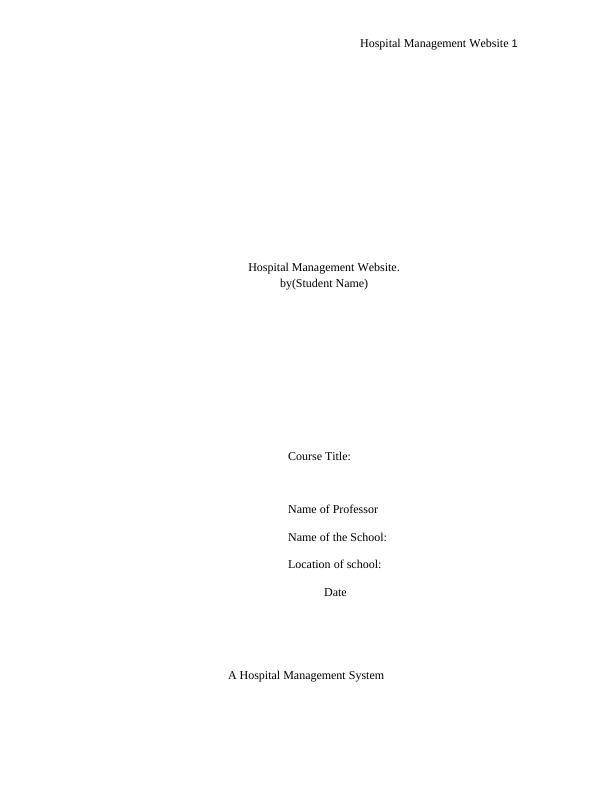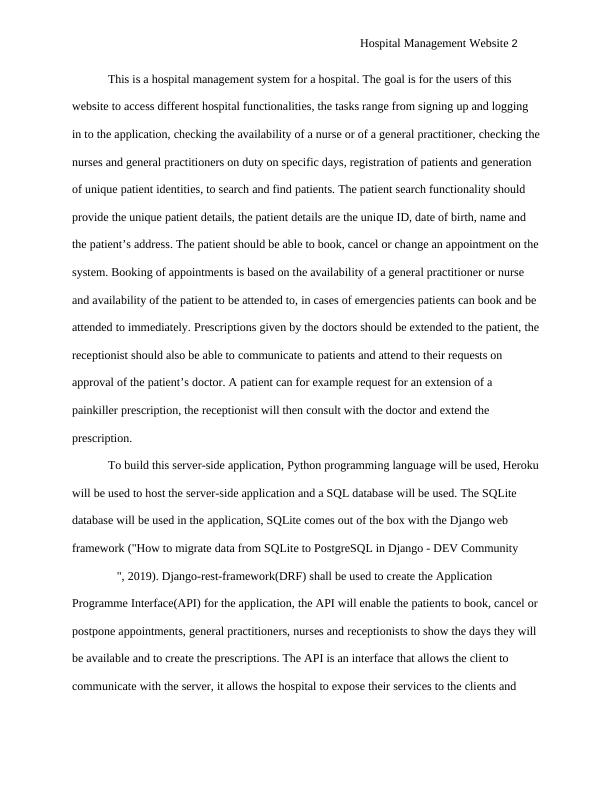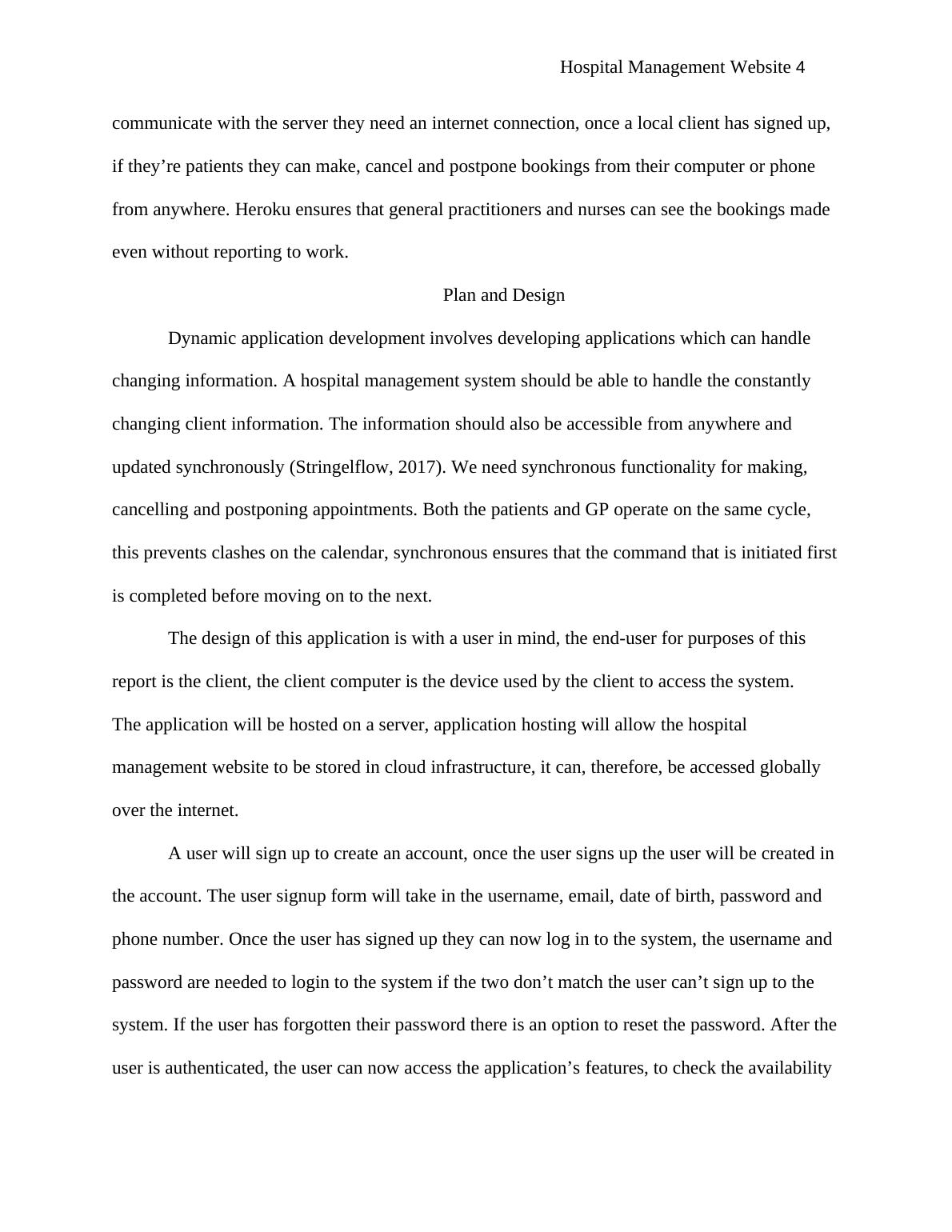Hospital Management Website.
Added on 2022-09-01
14 Pages3884 Words38 Views
Hospital Management Website 1
Hospital Management Website.
by(Student Name)
Course Title:
Name of Professor
Name of the School:
Location of school:
Date
A Hospital Management System
Hospital Management Website.
by(Student Name)
Course Title:
Name of Professor
Name of the School:
Location of school:
Date
A Hospital Management System

Hospital Management Website 2
This is a hospital management system for a hospital. The goal is for the users of this
website to access different hospital functionalities, the tasks range from signing up and logging
in to the application, checking the availability of a nurse or of a general practitioner, checking the
nurses and general practitioners on duty on specific days, registration of patients and generation
of unique patient identities, to search and find patients. The patient search functionality should
provide the unique patient details, the patient details are the unique ID, date of birth, name and
the patient’s address. The patient should be able to book, cancel or change an appointment on the
system. Booking of appointments is based on the availability of a general practitioner or nurse
and availability of the patient to be attended to, in cases of emergencies patients can book and be
attended to immediately. Prescriptions given by the doctors should be extended to the patient, the
receptionist should also be able to communicate to patients and attend to their requests on
approval of the patient’s doctor. A patient can for example request for an extension of a
painkiller prescription, the receptionist will then consult with the doctor and extend the
prescription.
To build this server-side application, Python programming language will be used, Heroku
will be used to host the server-side application and a SQL database will be used. The SQLite
database will be used in the application, SQLite comes out of the box with the Django web
framework ("How to migrate data from SQLite to PostgreSQL in Django - DEV Community 👩
", 2019)💻👨💻 . Django-rest-framework(DRF) shall be used to create the Application
Programme Interface(API) for the application, the API will enable the patients to book, cancel or
postpone appointments, general practitioners, nurses and receptionists to show the days they will
be available and to create the prescriptions. The API is an interface that allows the client to
communicate with the server, it allows the hospital to expose their services to the clients and
This is a hospital management system for a hospital. The goal is for the users of this
website to access different hospital functionalities, the tasks range from signing up and logging
in to the application, checking the availability of a nurse or of a general practitioner, checking the
nurses and general practitioners on duty on specific days, registration of patients and generation
of unique patient identities, to search and find patients. The patient search functionality should
provide the unique patient details, the patient details are the unique ID, date of birth, name and
the patient’s address. The patient should be able to book, cancel or change an appointment on the
system. Booking of appointments is based on the availability of a general practitioner or nurse
and availability of the patient to be attended to, in cases of emergencies patients can book and be
attended to immediately. Prescriptions given by the doctors should be extended to the patient, the
receptionist should also be able to communicate to patients and attend to their requests on
approval of the patient’s doctor. A patient can for example request for an extension of a
painkiller prescription, the receptionist will then consult with the doctor and extend the
prescription.
To build this server-side application, Python programming language will be used, Heroku
will be used to host the server-side application and a SQL database will be used. The SQLite
database will be used in the application, SQLite comes out of the box with the Django web
framework ("How to migrate data from SQLite to PostgreSQL in Django - DEV Community 👩
", 2019)💻👨💻 . Django-rest-framework(DRF) shall be used to create the Application
Programme Interface(API) for the application, the API will enable the patients to book, cancel or
postpone appointments, general practitioners, nurses and receptionists to show the days they will
be available and to create the prescriptions. The API is an interface that allows the client to
communicate with the server, it allows the hospital to expose their services to the clients and

Hospital Management Website 3
staff (Rouse, 2019). In this web application, the API will implement different methods to make
services available to its clients, the API will allow data to be used more efficiently and in an
easy manner (Sleter, 2014). Our API will ensure data protection, data will be protected and
access levels will be implemented, not everyone will be able to access all the data, only
permitted people will be able to access the API. Our choice of DRF for the API is due to its
speed in implementation, out of the box security features and flexibility (Guzman, 2019). The
API will follow a Representational State Transfer(REST) architecture. Django is the python
framework that will be used, DRF is a subset of Django, it follows the same principles and is
installed in a Django application for the purposes of creation of the REST API. REST API is
preferred due to being stateless, cacheable and having a uniform interface (Andrew, 2014). The
choice of rest is also due to REST implementing methods that make it easy to query, to create
you use the POST method, to remove you use the DELETE method, to retrieve you use the GET
method and to edit you use the PUT or PATCH methods (Lahoti, 2018). This makes it easy to
query data, create data, analyze and interpret data. REST also uses JavaScript Object Notation
(JSON) data type which formats data in a minimal and readable form. JSON is used for
communication between the client and the server (Farcic, 2014).
Heroku will be the cloud service provider, to run the application on different physical
computers it needs to be available on the cloud. Heroku will be the provider of the cloud
services, it will also handle the load balancing to ensure the services can be accessed by many
clients at the same time. The data will be stored on a HeroquPostgreSQL database once it is
deployed to the cloud. Load balancing will ensure the services are efficiently accessed by
multiple users logging in and using the services simultaneously. To deploy our application the
SQLite database will have to transfer the data to a PostgreSQL database. For the client to
staff (Rouse, 2019). In this web application, the API will implement different methods to make
services available to its clients, the API will allow data to be used more efficiently and in an
easy manner (Sleter, 2014). Our API will ensure data protection, data will be protected and
access levels will be implemented, not everyone will be able to access all the data, only
permitted people will be able to access the API. Our choice of DRF for the API is due to its
speed in implementation, out of the box security features and flexibility (Guzman, 2019). The
API will follow a Representational State Transfer(REST) architecture. Django is the python
framework that will be used, DRF is a subset of Django, it follows the same principles and is
installed in a Django application for the purposes of creation of the REST API. REST API is
preferred due to being stateless, cacheable and having a uniform interface (Andrew, 2014). The
choice of rest is also due to REST implementing methods that make it easy to query, to create
you use the POST method, to remove you use the DELETE method, to retrieve you use the GET
method and to edit you use the PUT or PATCH methods (Lahoti, 2018). This makes it easy to
query data, create data, analyze and interpret data. REST also uses JavaScript Object Notation
(JSON) data type which formats data in a minimal and readable form. JSON is used for
communication between the client and the server (Farcic, 2014).
Heroku will be the cloud service provider, to run the application on different physical
computers it needs to be available on the cloud. Heroku will be the provider of the cloud
services, it will also handle the load balancing to ensure the services can be accessed by many
clients at the same time. The data will be stored on a HeroquPostgreSQL database once it is
deployed to the cloud. Load balancing will ensure the services are efficiently accessed by
multiple users logging in and using the services simultaneously. To deploy our application the
SQLite database will have to transfer the data to a PostgreSQL database. For the client to

Hospital Management Website 4
communicate with the server they need an internet connection, once a local client has signed up,
if they’re patients they can make, cancel and postpone bookings from their computer or phone
from anywhere. Heroku ensures that general practitioners and nurses can see the bookings made
even without reporting to work.
Plan and Design
Dynamic application development involves developing applications which can handle
changing information. A hospital management system should be able to handle the constantly
changing client information. The information should also be accessible from anywhere and
updated synchronously (Stringelflow, 2017). We need synchronous functionality for making,
cancelling and postponing appointments. Both the patients and GP operate on the same cycle,
this prevents clashes on the calendar, synchronous ensures that the command that is initiated first
is completed before moving on to the next.
The design of this application is with a user in mind, the end-user for purposes of this
report is the client, the client computer is the device used by the client to access the system.
The application will be hosted on a server, application hosting will allow the hospital
management website to be stored in cloud infrastructure, it can, therefore, be accessed globally
over the internet.
A user will sign up to create an account, once the user signs up the user will be created in
the account. The user signup form will take in the username, email, date of birth, password and
phone number. Once the user has signed up they can now log in to the system, the username and
password are needed to login to the system if the two don’t match the user can’t sign up to the
system. If the user has forgotten their password there is an option to reset the password. After the
user is authenticated, the user can now access the application’s features, to check the availability
communicate with the server they need an internet connection, once a local client has signed up,
if they’re patients they can make, cancel and postpone bookings from their computer or phone
from anywhere. Heroku ensures that general practitioners and nurses can see the bookings made
even without reporting to work.
Plan and Design
Dynamic application development involves developing applications which can handle
changing information. A hospital management system should be able to handle the constantly
changing client information. The information should also be accessible from anywhere and
updated synchronously (Stringelflow, 2017). We need synchronous functionality for making,
cancelling and postponing appointments. Both the patients and GP operate on the same cycle,
this prevents clashes on the calendar, synchronous ensures that the command that is initiated first
is completed before moving on to the next.
The design of this application is with a user in mind, the end-user for purposes of this
report is the client, the client computer is the device used by the client to access the system.
The application will be hosted on a server, application hosting will allow the hospital
management website to be stored in cloud infrastructure, it can, therefore, be accessed globally
over the internet.
A user will sign up to create an account, once the user signs up the user will be created in
the account. The user signup form will take in the username, email, date of birth, password and
phone number. Once the user has signed up they can now log in to the system, the username and
password are needed to login to the system if the two don’t match the user can’t sign up to the
system. If the user has forgotten their password there is an option to reset the password. After the
user is authenticated, the user can now access the application’s features, to check the availability

End of preview
Want to access all the pages? Upload your documents or become a member.
